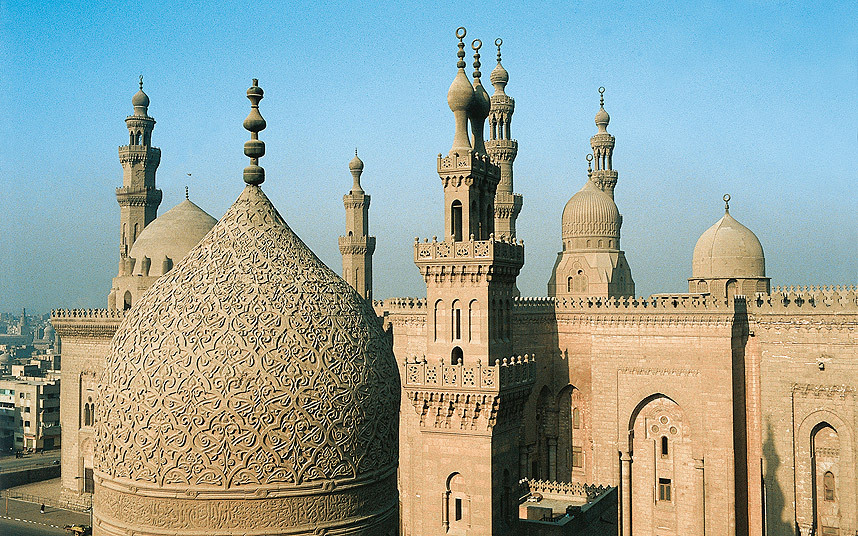The Aqsunqur Mosque (also known as the Blue Mosque or the Mosque of Ibrahim Agha) is located in Cairo, Egypt and is one of several "blue mosques" in the world. It is situated in the Tabbana Quarter in Islamic Cairo, between Bab Zuweila and the Citadel of Saladin (Cairo Citadel.) The Aqsunqur Mosque also serves as a funerary complex, containing the mausoleums of its founder Shams ad-Din Aqsunqur, his sons, a number of children of the Bahri Mamluk sultan an-Nasir Muhammad and that of its principal restorer, Ibrahim Agha al-Mustahfizan.
Architecture
Exterior
The general layout of the mosque consists of a large open courtyard (sahn) enclosed by four arcades (riwaqs.) There are three main entrances with the main portal opening into the western arcade. The latter consists of a large pointed arch with corbels on the front edges of its roof. Facing the courtyard is the dikka ("tribune") from which the Qur'an is recited. The structure uses Western European-style capitals that Islamic architecture expert Doris Behrens-Abouseif believes were taken from Crusader-era structures in the Levant.
Kujuk's mausoleum is situated at the portal's northern side and has two facades facing the street. Of the two alternative entrances, one opens into the southern arcade while the other opens between the northern and western arcades. Unlike other tombs in Cairo, Kujuk's mausoleum, which predates the mosque, is not aligned according to the qibla ("orientation with Mecca") and instead is aligned with the street. This structure is the principal feature unique to other major mosques in Egypt.
Above the prayer hall sits a brick one-bay dome carried on four brick squinches. A large brick dome supported by brick squinches is also situated atop the mausoleum of Kujuk. However, the latter has a pendentive below each squinch. When the mosque was originally built this technique of using plain squinches was considered classical. Two stone domes are located over the mausoleum of Tankizbugha and another stone dome is built above the tomb of Umm as-Sultan al-Sha'ban.
Interior
The mosque's interior also has an irregular layout mostly due to Ibrahim Agha's renovations which replaced most of the original cross-vaulting of the arcades with columns supporting a flat wooden ceiling. The only part of the mosque that continues to employ Aqsunqur's interior design is the qibla wall which uses cross-vaults that rest on octagonal-shaped piers. The technique of cross-vaults is a reflection of Islamic Syrian architectural influence. Along with the Mosque of Amir al-Maridani, the Aqsunqur Mosque has a hypostyle plan which is rare in Cairo and typically associated with Syrian style mosques.
The mihrab ("prayer niche" that indicates qibla) was built in a geometric interlace style typically found in Mamluk architecture. The design is used in the mihrab's spandrels. Other features of the mihrab include the hood's relief painted carvings, fluctuating lintel panels, marble panels, carved marble registers and mosaic inlay. To the right of the mihrab is the marble minbar ("pulpit.") Decorated with light gray, salmon, green and plum-colored stone inserts, it is the oldest and one of the handful remaining marble minbars used in a Cairo mosque. The handrail is also built of marble and has a pattern of rolling leaf and grape clusters carved from the stone.
Minaret
The minaret is situated at the southern corner of the facade looking into Bab al-Wazir Street, affording a dominant view of the entire southern part of the street. It consists of three stories, the first being circular and plain and the second circular and ribbed while the top story is a bulb resting on a pavilion supported by eight slender stone columns. Its circular shaft is rare among Mamluk minarets. Prior to its 20th-century restoration, the minaret had four stories. The third story was octagonal and removed during the restoration, depriving the Aqsunqur Mosque a unique feature it shared with another mosque in Cairo, the Sultan al-Ghuri Complex which has four stories. The Aqsunqur Mosque minaret was featured in several 19th-century illustrations.












